Levoča
| Levoča | ||
| Town | ||
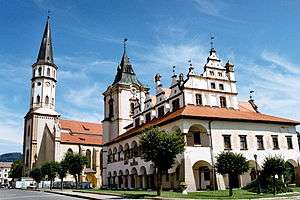 St. James Church and Levoča old town hall | ||
|
||
| Country | Slovakia | |
|---|---|---|
| Region | Prešov | |
| District | Levoča | |
| Elevation | 570 m (1,870 ft) | |
| Coordinates | 49°01′31″N 20°35′17″E / 49.02528°N 20.58806°ECoordinates: 49°01′31″N 20°35′17″E / 49.02528°N 20.58806°E | |
| Area | 64.042 km2 (25 sq mi) | |
| Population | 14,731 (2006-12-31) | |
| Density | 230/km2 (596/sq mi) | |
| Earliest mention | 1249 | |
| Mayor | Dr. Milan Majerský (elected November 2014) | |
| Timezone | CET (UTC+1) | |
| - summer (DST) | CEST (UTC+2) | |
| Postal code | 054 01 | |
| Phone prefix | 421-53 | |
| Car plate | LE | |
  Location in Slovakia | ||
| Website: http://www.levoca.sk | ||
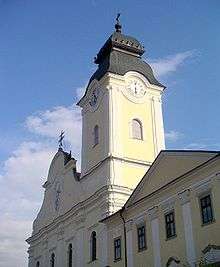
Levoča (![]() pronunciation ; Latin: Leuchovia, German: Leutschau, Hungarian: Lőcse, Polish: Lewocza) is a town in the Prešov Region of eastern Slovakia with a population of 14,600. The town has a historic center with a well preserved town wall, a Renaissance church with the highest wooden altar in the world, carved by Master Paul of Levoča, and many other Renaissance buildings.
pronunciation ; Latin: Leuchovia, German: Leutschau, Hungarian: Lőcse, Polish: Lewocza) is a town in the Prešov Region of eastern Slovakia with a population of 14,600. The town has a historic center with a well preserved town wall, a Renaissance church with the highest wooden altar in the world, carved by Master Paul of Levoča, and many other Renaissance buildings.
On 28 June 2009, Levoča was added by UNESCO to its World Heritage List.[1]
Etymology
The name is of Slovak origin and belongs to the oldest recorded Slovak settlement names in Spiš.[2] It was initially a name of stream Lěvoča, tributary of river Hornád (present-day Levočský potok). The name was probably motivated by an adjective lěva (left, a left tributary), Rudolf Krajčovič considered also lěvoča meaning "regularly flooded area".[3]
History
Levoča is located in the historical region of Spiš (Hungarian: Szepes), which was inhabited as early as the Stone Age. In the 11th century, this region was conquered and, subsequently, became part of the Kingdom of Hungary and remained such until 1918. After the Mongol invasions of 1241/1242, the area was also settled by Germans. The town became the capital of the Association of Spiš Germans, with a form of self-rule within the Kingdom of Hungary. The oldest written reference to the city of Levoča dates back to 1249. In 1317, Levoča (at that time generally known by the German name of Leutschau - see Chronology below for lists of changing names) received the status of a royal town. In 1321 a wide storing right was granted enticing merchants, craftsmen and mine owners to settle in this town.
In the 15th century the town, located on an intersection of trade routes between Poland and Hungary, became a rich center of commerce. It exported iron, copper, furs, leather, corn, and wine. At the same time the town became an important cultural centre. The English humanist Leonard Cox taught around 1520 in a school in Levoča. The bookseller Brewer from Wittenberg transformed his bookstore in a prolific printing plant, that lasted for 150 years. Finally, one of the best-known medieval woodcarvers Master Paul of Levoča settled here.
The town kept this cultural and economic status until the end of 16th century, in spite of two damaging fires : the first in 1550 destroyed nearly all of the Gothic architecture and another in 1599. In this period of prosperity several churches were built and the town had a school, library, pharmacy, and physicians. There was a printing press as early as 1624. Levoča was a center of the Protestant Reformation in Northern Hungary. The town started to decline during the anti-Habsburg uprisings in the 17th century.
In a lurid sequence of events in 1700, the mayor of the town was accidentally wounded by a local nobleman during a hunt, generating a series of revenge attacks, finally resulting in the murder of the mayor, Karol Kramler, a Saxon magistrate. The mayor's arm was then cut off, embalmed, and preserved in the town hall as a call to further revenge. This became the subject of a Hungarian novel about the town, The Black City, by the writer Kálmán Mikszáth.[4]
The economic importance of the town was further diminished in 1871 when the important new Košice–Bohumín Railway was built just 8 km (5.0 mi) to the south, bypassing Levoča and going through the nearby town of Igló, (today known by its Slovak name, Spišská Nová Ves). Later, in 1892, only a spur line was built from Spišská Nová Ves railway station to Levoča.
After the Treaty of Trianon and the dismantling of the Kingdom of Hungary, the city became part of the newly formed Czechoslovakia and its Slovak name Levoča was formally adopted. Later, during World War II, under the auspices of the First Slovak Republic, 981 local Jews were deported from the town to concentration camps. On 27 January 1945 Levoča was taken by Soviet troops of the 18th Army.
On July 3, 1995 Levoča was visited by Pope John Paul II. He celebrated a mass for 650,000 celebrants at the traditional pilgrim site of Mariánska hora, a hill about 2 kilometres (1 mile) north of Levoča with a spectacular view of the town.
Geography
Levoča lies at an altitude of 570 metres (1,870 feet) above sea level and covers an area of 64.042 square kilometres (24.727 sq mi).[5] It is located in the northern part of the Hornád Basin at the foothills of the Levoča Hills, at the stream Levočský potok, a tributary of Hornád. Poprad is 25 kilometres (16 miles) away to the west, Prešov 50 km (31 miles) to the east, Košice 90 km (56 miles) to the southeast and Bratislava 370 km (230 mi) to the southwest.
Historical Features
The old town is picturesquely sited and still surrounded by most of its ancient walls. In associating the town with Spiš Castle and Žehra in June 2009 as the renamed World Heritage Site of "Levoča, Spišský Hrad, and the Associated Cultural Monuments", UNESCO cites the town's historic center, its fortifications, and the works of Master Paul of Levoča preserved in the town.
The main entrance to the old town is via the monumental Košice Gate (15th century) behind which is located the ornate baroque Church of the Holy Spirit and the New Minorite Monastery (c. 1750).
The town square (Námestie Majstra Pavla - Master Paul’s Square) boasts three major monuments; the quaint Old Town Hall (15th-17th century) which now contains a museum, the domed Evangelical Lutheran Church (1837) and the 14th century Roman Catholic Church of St. James (in Slovak: Chrám svätého Jakuba, often mistakenly referred to in English as St. Jacob's). It houses a magnificently carved and painted wooden Gothic altar, the largest in Europe, (18.62 m (61.09 ft) in height), created by Master Paul around 1520. The square is very well preserved (despite one or two modern incursions) and contains a number of striking buildings which were the townhouses of the local nobility in the late Middle Ages. Also notable in the square is the wrought iron "Cage of Shame", dating back to the 17th century, used for public punishment of miscreants. A plaque on one of the houses records the printing and publication in the town of the most famous work of Comenius, the Orbis Pictus. Other buildings on the square house a historical museum and a museum dedicated to the work of Master Paul.
Behind the square on Kláštorská Street are the 14th-century church and remains of the old monastery of the Minorites, now incorporated into a Church grammar school. Nearby is the town's Polish Gate, a Gothic construction of the 15th century.
From the 16th century to the end of 1922, Levoca was the administrative center of the province of Szepes (Spiš). Between 1806 - 1826, the Hungarian architect from Eger Antal Povolny built a grandiose administration building, the Large Provincial House, as the seat of the town's administration. He adjusted its Classicist style to Levoca's Renaissance character by emphasizing the building's horizontal lines. The House is considered the most beautiful Provincial House in the former Kingdom of Hungary. Today, it is reconstructed and it is a seat of the administration.
The State Regional Archives (Štátny oblastný archív) are in a tan stone building on the north side of the square at nám. Majstra Pavla 60.
Demographics
Levoča has a population of 14,677 (as of December 31, 2005). According to the 2001 census, out of 14,366 inhabitants 87.07% were Slovaks 11.20% Romani, 0.33% Czechs and 0.31% Rusyns.[5] The religious make-up was 79.54% Roman Catholics, 9.01% people with no religious affiliation, 3.87% Greek Catholics and 1.61% Lutherans.[5]
Town and nearby settlements
- Levoča (main town)
- Levočská Dolina (=English: Levoča Valley). About 4 km (2 mi) out of town, on the way to Závada.
- Levočské Lúky (=English: Levoča Fields). Settlement on the road to Spišska Nová Ves.
- Závada. Village in the hills above Levočská Dolina.
Listing of town names
Below is a listing of names by which the town of Levoča has been known or recorded. The names were not necessarily at any time mutually exclusive and often reflect minor linguistic differences.:[6][7]
- 1249: Leucha
- 1268: Lyucha
- 1271: Lewcha
- 1277: Lyucha
- 1284: Leuche, Lyuche, Leiuche
- 1408: Lewscen
- 1479: Lewcsouia
- 1497: Leutschaw
- 1773: Lewucža
- 1786: Lewoče, Lőcse (Hungarian), Leutschau (German), Leuchovia (Latin), Leutschovia, Leutsaria
- 1808: Leutsovia, Lőcse, Leutschau, Lewoča
- 1863 - 1913: official name: Lőcse
- since 1920: official name: Levoča
International relations
Twin towns — Sister cities
Levoča is twinned with:
 Stary Sącz, Poland
Stary Sącz, Poland Łańcut, Poland [8]
Łańcut, Poland [8] Kalwaria Zebrzydowska, Poland
Kalwaria Zebrzydowska, Poland Keszthely, Hungary
Keszthely, Hungary Litomyšl, Czech Republic
Litomyšl, Czech Republic
Gallery
- Levoca
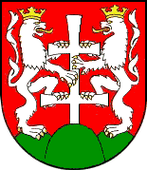 Levoča Coat of Arms
Levoča Coat of Arms Levoča from Mariánska hora
Levoča from Mariánska hora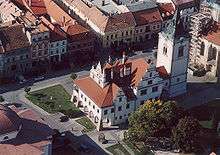 Levoča - Town hall from above
Levoča - Town hall from above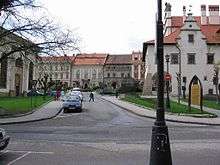 Levoča main square
Levoča main square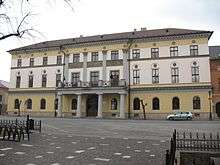 The Large Provincial House
The Large Provincial House- Levoča main square
 Sculptures from Master Paul's altar in St. James's Church
Sculptures from Master Paul's altar in St. James's Church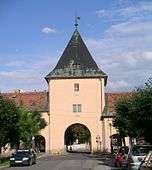 The Košice Gate
The Košice Gate Doorway of the New Minorite Cloisters
Doorway of the New Minorite Cloisters
See also
References
Notes
- ↑ UNESCO Newswebsite
- ↑ Štefánik, Martin; Lukačka, Ján, eds. (2010). Lexikón stredovekých miest na Slovensku [Lexicon of Medieval Towns in Slovakia] (PDF) (in Slovak). Bratislava: Historický ústav SAV. p. 252. ISBN 978-80-89396-11-5.
- ↑ Krško, Jaromír (2015). "Lexikálne východiská starej slovenskej hydronymie z povodia Hornádu v slovanskom kontexte" [Lexical origin of the old Slovak hydronymy from the Hornád river basin in the Slavonic context] (PDF). Slavica Slovaca (in Slovak). Slavistický ústav Jána Stanislava SAV (1): 10.
- ↑ Jan Lácika, Spiš, 1999, p. 57
- 1 2 3 "Municipal Statistics". Statistical Office of the Slovak republic. Archived from the original on 2006-12-30. Retrieved 2007-01-08.
- ↑ Vlastivedný Slovník Obcí na Slovensku, VEDA, vydavateľstvo Slovenskej akadémie vied, Bratislava 1978.
- ↑ Milan Majtán (1998). Názvy Obcí Slovenskej republiky (Vývin v rokoch 1773-1997), VEDA, vydavateľstvo Slovenskej akadémie vied, Bratislava, ISBN 80-224-0530-2.
- ↑ Łańcut Official Website
External links
| Wikivoyage has a travel guide for Levoča. |
- Official website of Levoča
- St. James's Church
- Official website of Tourist Information Centre in Levoča
- Article about Levoča at Spectacular Slovakia
- Levoča International Music Festival ('Indian Summer in Levoča')
- The Large Provincial House (student work)
| Wikimedia Commons has media related to Levoča. |